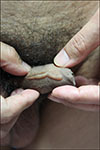1. Kikuchi K, Fukunaga S, Inoue H, Miyazaki Y, Ide F, Kusama K. Apocrine hidrocystoma of the lower lip: a case report and literature review. Head Neck Pathol. 2014; 8:117–121.

2. Mehregan AH. Apocrine cystadenoma; a clinicopathologic study with special reference to the pigmented variety. Arch Dermatol. 1964; 90:274–279.
3. Samplaski MK, Somani N, Palmer JS. Apocrine hidrocystoma on glans penis of a child. Urology. 2009; 73:800–801.

4. Ahmed A, Jones AW. Apocrine cystadenoma. A report of two cases occurring on the prepuce. Br J Dermatol. 1969; 81:899–901.

5. Powell RF, Palmer CH, Smith EB. Apocrine cystadenoma of the penile shaft. Arch Dermatol. 1977; 113:1250–1251.

6. de Dulanto F, Armijo-Moreno M, Camacho Martinez F. [Nodular hidradenoma (apocrine cystadenoma) of the penis]. Ann Dermatol Syphiligr (Paris). 1973; 100:417–422. French.
7. Flessati P, Camoglio FN, Bianchi S, Fasoli L, Menghi A. [An apocrine hidrocystoma of the scrotum. A case report]. Minerva Chir. 1999; 54:87–89. Italian.
8. Glusac EJ, Hendrickson MS, Smoller BR. Apocrine cystadenoma of the vulva. J Am Acad Dermatol. 1994; 31(3 Pt 1):498–499.

9. Mataix J, Bañuls J, Blanes M, Pastor N, Betlloch I. Translucent nodular lesion of the penis. Apocrine hidrocystoma of the penis. Arch Dermatol. 2006; 142:1221–1226.
10. Liu YS, Wang JS, Li TS. A 25-year-old man with a domeshaped translucent nodule on the glans penis. Dermatol Sin. 2010; 28:177–178.

11. López V, Alonso V, Jordá E, Santonja N. Apocrine hidrocystoma on the penis of a 40-year-old man. Int J Dermatol. 2013; 52:502–504.

12. Park J, Kim I, Jang HC, Chae IS, Park K, Kim Y, et al. Linear skin-coloured papules on scrotum: a quiz. Apocrine hidrocystoma. Acta Derm Venereol. 2015; 95:762–763.
13. Taylor D, Juhl ME, Krunic AL, Sidiropoulos M, Gerami P. Apocrine hidrocystoma of the urethral meatus: a case report. Acta Derm Venereol. 2015; 95:376–377.

14. Vani D, T R D, H B S, M B, Kumar HR, Ravikumar V. Multiple apocrine hidrocystomas: a case report. J Clin Diagn Res. 2013; 7:171–172.
15. Sarabi K, Khachemoune A. Hidrocystomas--a brief review. MedGenMed. 2006; 8:57.
16. Ohnishi T, Watanabe S. Immunohistochemical analysis of cytokeratin expression in apocrine cystadenoma or hidrocystoma. J Cutan Pathol. 1999; 26:295–300.

17. Persec Z, Persec J, Sovic T, Rako D, Bacalja J, Hrgovic Z, et al. Median raphe cyst–clinical report and immunohistochemical analysis. J Clin Exp Dermatol Res. 2013; S6:011.

18. Deliktas H, Sahin H, Celik OI, Erdogan O. Median raphe cyst of the penis. Urol J. 2015; 12:2287–2288.
19. Dini M, Baroni G, Colafranceschi M. Median raphe cyst of the penis: a report of two cases with immunohistochemical investigation. Am J Dermatopathol. 2001; 23:320–324.





 PDF
PDF ePub
ePub Citation
Citation Print
Print





 XML Download
XML Download